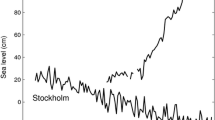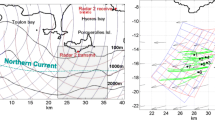Abstract
A method has been developed to monitor the surface velocity field by combining repeated acoustic Doppler current profiler (ADCP) observations and satellite altimetry data. The geostrophic velocity anomaly is calculated from the sea surface height anomaly field estimated from the altimetry data by an optimal interpolation. It has been confirmed that this accurately observes the smoothed velocity anomaly field when the interpolation scales are set according to the spatio-temporal sampling pattern of the altimeter used. The velocity anomaly obtained from the altimetry data is subtracted from the repeated ADCP observations to estimate temporal mean velocity along the ship tracks. Regularly sampled, nine-year time series of surface velocity can then be obtained by adding the computed mean velocity and the altimetry anomaly components. This clearly illustrates surface velocity fluctuations such as the movement of the Kuroshio axis due to its meandering and an increase of the interannual variability of the Subtropical Countercurrent toward its downstream region.
Similar content being viewed by others
References
Aoki, Y., T. Suga and K. Hanawa (2002): Subsurface subtropical fronts of the North Pacific as inherent boundaries in the ventilated thermocline. J. Phys. Oceanogr., 32, 2299–2311.
AVISO (1996): AVISO Handbook for Merged TOPEX/ POSEIDON Products. AVI-NT-02-101-CN, Edition 3.0.
Hanawa, K., Y. Yoshikawa and T. Taneda (1996): TOLEXADCP monitoring. Geophys. Res. Lett., 23, 2429–2432.
Hasunuma, K. and K. Yoshida (1978): Splitting of the subtropical gyre in the western North Pacific. J. Oceanogr. Soc. Japan, 34, 160–172.
Ichikawa, K. (2001): Variation of the Kuroshio in the Tokara Strait induced by meso-scale eddies. J. Oceanogr., 57, 55–68.
Ichikawa, K. and S. Imawaki (1994): Life history of a cyclonic ring detached from the Kuroshio Extension as seen by the Geosat altimeter. J. Geophys. Res., 99(C8), 15953–15966.
Ichikawa, K. and S. Imawaki (1996): Estimating sea surface dynamic topography from Geosat altimetry data. J. Oceanogr., 52, 43–68.
Ichikawa, K., S. Imawaki and H. Ishii (1995): Comparisons of altimetry-derived geostrophic velocities and surface velocities determined from drifting buoy trajectory south of Japan. J. Oceanogr., 51, 729–740.
Kamachi, M., T. Kuragano, S. Sugimoto, K. Yoshita, T. Sakurai, T. Nakano, N. Usui and F. Uboldi (2004): Short-range prediction experiments with operational data assimilation system for the Kuroshio south of Japan. J. Oceanogr., 60, this issue, 269–282.
Kaneko, A., M. Arai, N. Gohda, T. Sugimoto, H. Nakajima, Z. Yuan, H. Zheng, X. Zhu and S. Yamane (1998): ADCP observation of the western equatorial Pacific by a commercial ship. Oceanogr. Japan, 7, 357–368 (in Japanese with English abstracts).
Kaneko, A., N. Gohda, M. Arai, H. Nakajima and Z. Yuan (1999): Repeat ADCP survey of the Western Pacific surface current by a commercial ship. WOCE News Lett., 34, 31–35.
Kaneko, A., Z. Yuan, N. Gohda, M. Arai, H. Nakajima, H. Zheng and T. Sugimoto (2001): Repeat meridional 6survey of the western North Pacific subtropical gyre by a VOS ADCP during 1997 to 1998. Geophys. Res. Lett., 28, 3429–3432.
Kobashi, F. and H. Kawamura (2002): Seasonal variation and instability nature of the North Pacific Subtropical Countercurrent and Hawaiian Lee Countercurrent. J. Geophys. Res., 107(C11), 3185, doi:10.1029/2001JC001225.
Le Traon, P. Y. and F. Ogor (1998): ERS-1/2 orbit improvement using TOPEX/POSEIDON: the 2cm challenge. J. Geophys. Res., 103(C4), 8045–8057.
Le Traon, P. Y., P. Gaspar, F. Bouyssel and H. Makhmara (1995): Using TOPEX/POSEIDON data to enhance ERS-1 data. J. Atmos. Ocean. Tech., 12, 161–170.
National Research Council (1997): Satellite Gravity and the Geosphere: Contributions to the Study of the Solid Earth and Its Fluid Envelopes. National Academy Press, Washington, D.C., 126 pp., ISBN 0-309-05792-2.
Qiu, B. (1999): Seasonal eddy field modulation of the North Pacific subtropical countercurrent: TOPEX/Poseidon observations and theory. J. Phys. Oceanogr., 29, 2471–2486.
Qiu, B., K. A. Kelly and T. M. Joyce (1991): Mean flow and variability in the Kuroshio Extension from Geosat altimetry data. J. Geophys. Res., 96(C10), 18,491–18,501.
Tanaka, K. and M. Ikeda (2004): Propagation of Rossby waves over ridges excited by interannual wind forcing in a western North Pacific model. J. Oceanogr., 60, this issue, 329–340.
Teague, W. J., M. J. Carron and P. J. Hogan (1990): A comparison between the generalized digital environmental model and Levitus climatologies. J. Geophys. Res., 95(C5), 7167–7183.
Uchida, H. and S. Imawaki (2003): Eulerian mean surface velocity field derived by combining drifter and satellite altimeter data. Geophys. Res. Lett., 30(5), 1229, doi:10.1029/ 2002GL016445.
Author information
Authors and Affiliations
Rights and permissions
About this article
Cite this article
Ichikawa, K., Gohda, N., Arai, M. et al. Monitoring Surface Velocity from Repeated ADCP Observations and Satellite Altimetry. Journal of Oceanography 60, 365–374 (2004). https://doi.org/10.1023/B:JOCE.0000038342.87237.e3
Issue Date:
DOI: https://doi.org/10.1023/B:JOCE.0000038342.87237.e3




